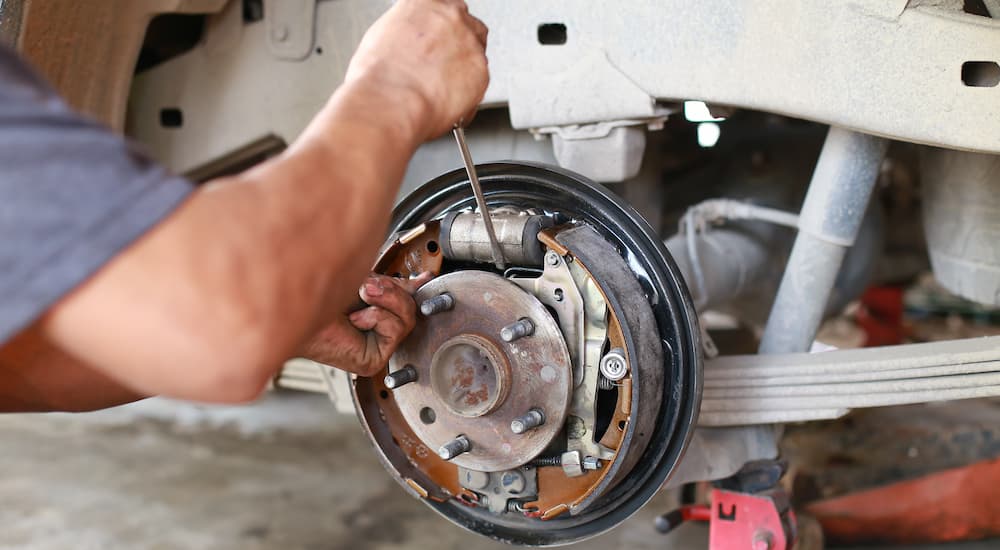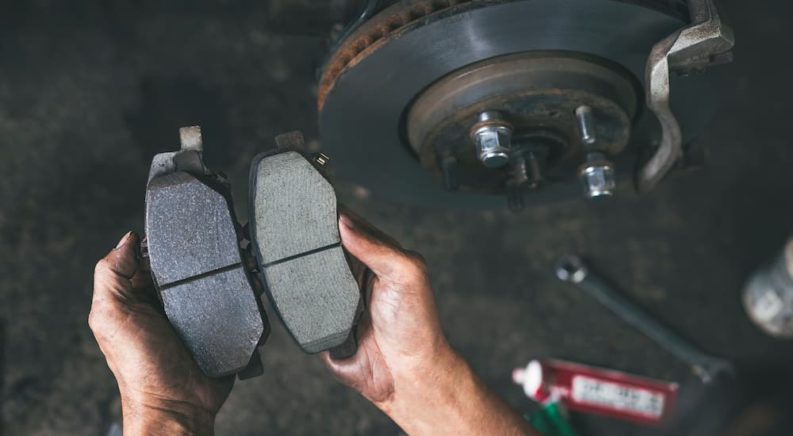How often do you think about the brakes on your vehicle? While most people don’t give their brakes much thought, your brakes are vital to your safety and play a prominent role in how your car, truck, or SUV performs. If you’ve ever had brake trouble, you know just how scary it can be if your brakes fail or don’t work correctly. Perhaps you’re currently in this situation, inspiring your search for brake service near you. Fortunately, you’re in the right place.
While most drivers don’t think about their brakes until the unthinkable happens, we’re here to help you proactively maximize your vehicle’s stopping power. To do this starts by understanding how your brakes work and the different types of brakes you’ll find on cars, trucks, and SUVs today. From there, we’ll look at the warning signs that indicate it’s time for brake repair or a thorough inspection that will optimize your safety and your vehicle’s performance and longevity on the road.
How Do Brakes Work?
Engaging the brake pedal in your vehicle brings your vehicle to a stop, but how does this simple action bring this much power and weight to a halt? There’s a lot going on behind the scenes, and it begins when you depress the brake pedal with your foot. This action alone wouldn’t do much to stop the vehicle because you don’t have the physical strength needed for the brakes to do their jobs. That’s where the brake system comes in, multiplying the force of your foot through leverage, hydraulic forces, and friction.
Modern vehicles are equipped with hydraulic brakes consisting of a master cylinder, power brake booster, brake lines and hoses, and brake assemblies. When you engage the brake pedal, the master brake rod pushes against the internal piston seals in the master cylinder to pressure the fluid and force it into the brake lines, calipers, and wheel cylinders. This force causes the brake pads to press against the rotors and the brake shoes to press against the brake drums to create the friction needed to stop the vehicle.

Disc Brakes vs Drum Brakes
There are two types of brake assemblies used in modern vehicles: disc brakes or drum brakes. Disc brakes are far more common because they effectively dissipate heat and are reliable in wet conditions. In contrast, drum brakes are more affordable to replace because of their simple design; however, this design makes them prone to withholding water, which can lead to corrosion and rust. So, what’s the difference in the designs?
Disc brakes rely on brake pads, calipers, rotors, and hydraulic fluid to bring your vehicle to a stop, much like the process described above. Drum brakes rely on a drum attached to the interior of the wheel so that when the brake pedal is engaged, the pressure forces the brake shoes against the drum to generate friction. This wedge or jamming action likens itself to how a coaster brake works on a bicycle, creating heat and friction between the tire and road to slow the wheels and bring the vehicle to a stop.
Regenerative Brakes
The rising popularity of hybrid and electric vehicles has introduced more drivers to regenerative braking systems. Automakers tout these systems for their ability to add range to the battery. But how does it work? With a regenerative braking system, the electric drive motor runs backward anytime the accelerator or brake pedal isn’t engaged. This backward movement creates drag on the wheels, safely slowing the car and producing enough energy to recharge the battery.
Signs Your Brakes Need Repair
Education and proactive maintenance are crucial to your safety on the road, especially when it comes to your brakes. Most dealerships will inspect your brakes during routine oil changes, but it’s good to know the basic warning signs of common brake issues. You’ll find that many of these signs overlap and point to similar concerns or repairs that trained mechanics can expertly diagnose.
#1 Brake Light Indicator
The most common indication that your brakes need repair is the brake light indicator on your driver instrument display. Although this light doesn’t go into specifics, you can refer to your vehicle owner’s manual for possible causes. It’s also a fail-safe indication that it’s time to have your brake system inspected.
#2 Squealing, Screeching, Grinding, and Squeaking
Your brakes shouldn’t make any odd noises, so it’s essential to pay attention if you hear squealing, squeaking, grinding, or screeching noises when you engage the brake pedal. These noises could indicate it’s time to replace the brake pads or shoes. Brake pads wear down with use, especially if you tend to ride the brakes. As these pads wear down, metal becomes exposed, so when you apply the brakes, metal rubs against metal and produces high-pitched noises.
#3 Vibrations in the Steering Wheel
Brake rotors stop the wheels from spinning as the brake pads engage, generating friction to slow the vehicle. With this motion, the material from the brake pads can unevenly rub off on the surface of the rotor. This uneven layer can cause problems for the brake rotor, leading to vibrations when you apply the brakes. Fortunately, this is a relatively easy fix where your mechanic will smooth the rotor to correct any flaws or uneven wear. If the rotors have excessive wear, your mechanic will recommend replacing them to optimize your safety.
#4 Soft or Hard Brakes
Engaging the brake pedal should come with some resistance, which means a soft or spongy brake is a cause for concern. If your brake pedal is easy to engage or goes all the way to the floorboard, it’s time to have your brakes inspected. This sponge-like feel could indicate an issue with the master cylinder or moisture in the braking system.
On the other hand, having to apply excessive force to engage the brake pedal is also an indication of brake trouble. For example, this extra effort could indicate that your brake calipers or wheel cylinders have seized or that the master cylinder is defective. It could also mean the brake hoses have failed or the brake linings are contaminated.
#5 Fluid Leaks
Brake fluid is an integral part of your braking system because it creates the hydraulic pressure needed to engage the caliper, which makes leaking fluid a tell-tale sign of brake trouble. Leaking brake fluid poses a significant risk because, without the fluid, your vehicle can’t safely stop. Your dealership will usually check the brake fluid during every oil change, but if you see any signs of a leak, don’t hesitate to bring your vehicle in for service.
#6 Pulling to One Side
One of the most complex symptoms of brake repair occurs when your vehicle pulls to one side when you engage the brakes. Why is this an issue? This behavior could indicate several concerns, from a faulty brake hose to problems with the caliper. Diagnosing the problem requires a reputable mechanic and a comprehensive inspection of the brake system.

Taking a Proactive Approach to Your Brakes
There’s no question that your brakes are vital to your safety and how your vehicle performs. A faulty braking system puts you at greater risk for an accident by reducing your vehicle’s ability to stop safely. Fortunately, you can mitigate this risk by taking a proactive approach to maintaining your brakes. You’re already off to a great start by learning more about your brakes and how they work. Next, we encourage you to be mindful of the common signs of brake issues and have a licensed and trained mechanic you trust routinely inspect your vehicle’s only stopping power.

